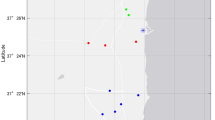Abstract
The paper considers probabilistic properties of the plug-in estimator of the cepstrum (Fourier transform of the logarithm of the spectral density) for stationary Gaussian time series. In the asymptotics of increasing observation time under some regularity condition we construct asymptotic expansions for the high-order central mixed moments of the log-periodogram and of the cepstrumestimator. These asymptotic expansions can be useful in signal processing for construction and performance analysis of statistical inference based on the plug-in estimator of the cepstrum.
Similar content being viewed by others
References
P. Alexandre and P. Lockwood, “Root Cepstral Analysis: A Unified View. Application to Speech Processing in Car Noise Environments”, Speech Communication 12(3), 277–288 (1993).
S. Amari and H. Nagaoka, Methods of Information Geometry (Oxford University Press, 2000).
T.W. Anderson, The Statistical Analysis of Time Series (Wiley, New York, 1994).
J. Arteche and J. Orbe, “Bootstrap-Based Bandwidth Choice for Log-Periodogram Regression”, J. Time Series Analysis 6, 591–617 (2009).
H. Bateman, Higher Transcendental Functions (Krieger, New York, 1981), Vol. 1.
P. Bloomfield, “An Exponential Model for the Spectrum of a Scalar Time Series”, Biometrika 60, 217–226 (1973).
D. Brillinger, Time Series. Data Analysis and Theory (Holt, Rinehart and Winston, New York, 1975).
R. Butler, “Shear Wave Properties of Marine Sediments Derived from Cepstral Analysis of Background Noise”, Geophysical Research Letters 15(8), 836–839 (1988).
D. G. Childers, D. P. Skinner, and R. C. Kemerait, “The Cepstrum: A Guide to Processing”, IEEE Proc. 65(10), 1428–1443 (1977).
F. R. Gantmacher, Matrix Theory (Chelsea Publishing, New York, 1960).
Yu. S. Kharin, “Optimality and Robustness in Statistical Forecasting”, International Encyclopedia of Statistical Science 15, 1034–1037 (2011).
Yu. S. Kharin and V. A. Voloshko, Robust Estimation of AR Coefficients under Simultaneously Influencing Outliers and Missing Values”, J. Statist. Plann. Inference 141(9), 3276–3288 (2011).
D. J. Lee, T. F. Krile, and S. Mitra, “Power Cepstrum and Spectrum Techniques Applied to Image Registration”, Appl. Optics 27(6), 1099–1106 (1988).
D. J. Lee, S. Mitra, and T. F. Krile, “Analysis of Sequential Complex Images, Using Feature Extraction and Two-Dimensional Cepstrum Techniques”, J. Opt. Soc. Amer. A 6(6), 863–870 (1989).
N. Merhav, “On the Asymptotic Statistical Behavior of Empirical Cepstral Coefficients”, IEEE Trans. on Signal Processing 41(5), 1990–1993 (1993).
A.M. Noll, “Cepstrum Pitch Determination”, J. Amer. Statist. Assoc. 41(2), 293–309 (1967).
A. V. Oppenheim and R.W. Shafer, Discrete-Time Signal Processing (Englewood Cliffs, NJ: Prentice Hall, 1989).
V. A. Reisen, E. Moulines, P. Soulier, and G. C. Franco, “On the Properties of the Periodogramof a Stationary Long-Memory Process over Different Epochs with Applications”, J. Time Series Analysis 1, 20–36 (2010).
V. Scheidemann, Introduction to Complex Analysis in Several Variables (Birkhauser, Basel-Boston-Berlin, 2005).
A. N. Shiryaev, Probability (Springer, Berlin, 1994).
P. W. Smith and N. Nandhakumar, “An Improved Power Cepstrum Based Stereo Correspondence Method for Textured Scenes”, IEEE Trans. on Patt. Anal. and Machine Intell. 18(3), 338–348 (1996).
V. A. Voloshko and Yu. S. Kharin, “Statistical Forecasting Based on Bloomfield Exponential Model”, in Proc. 9th International Conference on Computer Data Analysis and Modeling (CDAM), Ed. by S. Aivazian, P. Filzmoser, Yu. Kharin (BSU, Minsk, 2010), Vol. 1, pp. 268–271.
F. S. Wei and M. Li, “Cepstrum Analysis of Seismic Source Characteristics”, Acta Seismologica Sinica 16(1), 50–58 (2003).
Y. Yeshurun and E. L. Schwartz, “Cepstral Filtering on a Column Image Architecture: A Fast Algorithm for Binocular Stereo Algorithm”, IEEE Trans. on Patt. Anal. and Machine Intell. 11(7), 759–767 (1989).
Author information
Authors and Affiliations
Corresponding author
About this article
Cite this article
Kharin, Y.S., Voloshko, V.A. On asymptotic properties of the plug-in cepstrum estimator for Gaussian time series. Math. Meth. Stat. 21, 43–60 (2012). https://doi.org/10.3103/S1066530712010036
Received:
Published:
Issue Date:
DOI: https://doi.org/10.3103/S1066530712010036



